12. 5. 1. Troubleshooting > Problems with the printing quality >
Printing is faint
Printing is faint
| Cause | Corrective Action |
| You may be printing on the wrong side of the paper. | Print on the printing surface. |
| The Printhead nozzles are clogged. | Print a test pattern to check the nozzles and see if they are clogged.
(See "Checking for Nozzle Clogging (11.2.2).")
|
| Because the printer was left without ink tanks installed for some time, ink has become clogged in the ink supply system. | After the ink tanks have been installed for 24 hours, run Head Cleaning B from the Control Panel.
(See "Cleaning the Printhead (11.2.3).")
|
| Paper is jammed inside the Top Cover. | Follow the steps below to remove the jammed piece of paper inside the Top Cover.
1. Open the Top Cover and make sure the Carriage is not over the Platen.
2. Remove any scraps of paper inside the Top Cover.
(See "Clearing Jammed Roll Paper (12.2.2).")
(See "Clearing a Jammed Sheet, Fed Manually (12.2.3).")
3. Close the Top Cover.
|
| The ink was not dry when paper was cut. | Specify a longer drying period in the Control Panel menu, in Paper Details >Roll DryingTime.
(See "Menu Settings (9.2.4).")
|
| Printing may be faint if Print Quality in Advanced Settings in the printer driver is set to Standard or Draft. | In Advanced Settings of the printer driver, choose Highest or High in Print Quality.
Printing in Draft or Standard mode is faster and consumes less ink than in Highest or High modes, but the printing quality is lower.
(See "Giving Priority to Particular Graphic Elements and Colors for Printing (2.3.4).")
|
| You are printing on paper that tends to generate dust when cut. | In the Control Panel menu, set CutDustReduct. in Paper Details to On.
(See "Reducing Dust from Cutting Rolls (6.2.14).")
|
12. 5. 2. Troubleshooting > Problems with the printing quality >
Paper rubs against the printhead
Paper rubs against the printhead
| Cause | Corrective Action |
| The type of paper specified in the printer driver does not match the type loaded in the printer. | Load paper of the same type as you have specified in the printer driver.
(See "Loading Rolls in the Printer (6.2.2).")
(See "Loading Sheets in the Feed Slot (6.3.1).")
|
| Make sure the same type of paper is specified in the printer driver as you have loaded in the printer.
1. Press the Stop button and stop printing.
2. Change the type of paper in the printer driver and try printing again.
|
|
| Paper has been loaded incorrectly, causing it to wrinkle. | Reload the paper.
(See "Loading Rolls in the Printer (6.2.2).")
(See "Loading Sheets in the Feed Slot (6.3.1).")
|
| The Printhead is set too low in the Control Panel menu. | In the Control Panel menu, set Head Height to Automatic.
(See "Troubleshooting Paper Abrasion and Blurry Images (Head Height) (7.2.4).")
|
| You are printing on heavyweight paper or paper that curls or wrinkles easily after absorbing ink. | When printing on Heavyweight Coated Paper or other paper-based media, choose a VacuumStrngth setting of Strong or Strongest in the Control Panel menu. If rubbing still occurs, in the Control Panel menu, use a higher Head Height setting.
(See "Adjusting the Vacuum Strength (VacuumStrngth) (7.3.8).")
(See "Troubleshooting Paper Abrasion and Blurry Images (Head Height) (7.2.4).")
|
| When printing on CAD Tracing Paper or other film-based media, choose a VacuumStrngth setting of Standard, Strong, or Strongest in the Control Panel menu. If rubbing still occurs, in the Control Panel menu, use a higher Head Height setting.
(See "Adjusting the Vacuum Strength (VacuumStrngth) (7.3.8).")
(See "Troubleshooting Paper Abrasion and Blurry Images (Head Height) (7.2.4).")
|
|
| When printing on paper 0.1 mm (0.004 in) thick or less, choose a VacuumStrngth setting of Weakest in the Control Panel menu. If rubbing still occurs, in the Control Panel menu, use a higher Head Height setting.
(See "Adjusting the Vacuum Strength (VacuumStrngth) (7.3.8).")
(See "Troubleshooting Paper Abrasion and Blurry Images (Head Height) (7.2.4).")
|
|
| If edges of the paper curl and become soiled when printing on rolls of glossy photo paper, in Paper Detailed Settings in the printer driver, set Near End Margin to 20mm. | |
| When you have loaded paper, the paper you have loaded does not match the type selected on the Control Panel. | Be sure to select the correct type of paper in the Control Panel menu when loading paper.
(See "Loading Rolls in the Printer (6.2.2).")
(See "Loading Sheets in the Feed Slot (6.3.1).")
|
12. 5. 3. Troubleshooting > Problems with the printing quality >
The edges of the paper are dirty
The edges of the paper are dirty
| Cause | Corrective Action |
| The Platen has become dirty after borderless printing or printing on small paper. | Open the Top Cover and clean the Platen.
(See "Cleaning Inside the Top Cover (11.4.2).")
|
| The type of paper as specified on the printer does not match the type specified in the printer driver. | Make sure the same type of paper is specified on the printer as in the printer driver.
(See "Changing the Type of Paper (6.2.3).")
|
| Make sure the same paper type is specified in the printer driver as on the printer.
1. Press the Stop button and stop printing.
2. Change the type of paper in the printer driver and try printing again.
|
|
| The paper is wrinkled or warped. | Straighten out the wrinkles or curls and reload the paper. Do not use paper that has been printed on previously.
(See "Loading Rolls in the Printer (6.2.2).")
(See "Loading Sheets in the Feed Slot (6.3.1).")
|
| A cut line is printed because CutDustReduct. is On in the Control Panel menu to reduce cutting dust. | If this function is not needed, set CutDustReduct. to Off in the Control Panel menu.
(See "Menu Settings (9.2.4).")
|
| The Printhead is set too low in the Control Panel menu. | In the Control Panel menu, set Head Height to Automatic.
(See "Troubleshooting Paper Abrasion and Blurry Images (Head Height) (7.2.4).")
|
| You are printing on heavyweight paper or paper that curls or wrinkles easily after absorbing ink. | When printing on Heavyweight Coated Paper or other paper-based media, choose a VacuumStrngth setting of Strong or Strongest in the Control Panel menu. If rubbing still occurs, in the Control Panel menu, use a higher Head Height setting.
(See "Adjusting the Vacuum Strength (VacuumStrngth) (7.3.8).")
(See "Troubleshooting Paper Abrasion and Blurry Images (Head Height) (7.2.4).")
|
| When printing on CAD Tracing Paper or other film-based media, choose a VacuumStrngth setting of Standard, Strong, or Strongest in the Control Panel menu. If rubbing still occurs, in the Control Panel menu, use a higher Head Height setting.
(See "Adjusting the Vacuum Strength (VacuumStrngth) (7.3.8).")
(See "Troubleshooting Paper Abrasion and Blurry Images (Head Height) (7.2.4).")
|
|
| The Ejection Guide is soiled. | Clean the Ejection Guide.
(See "Cleaning the Printer Exterior (11.4.1).")
|
12. 5. 4. Troubleshooting > Problems with the printing quality >
The surface of the paper is dirty
The surface of the paper is dirty
| Cause | Corrective Action |
| The Paper Retainer is soiled. | Clean the Paper Retainer.
(See "Cleaning Inside the Top Cover (11.4.2).")
|
| You are using a paper that does not dry easily. | In the Control Panel menu, set Roll DryingTime to at least 1 min.
(See "Menu Settings (9.2.4).")
|
| When paper that does not dry easily is used for printing, it may curl during printing and touch the Output Tray.
In this case, in the Control Panel menu, set Scan Wait Time to an option other than Off.
However, note that printing will now take longer.
(See "Menu Settings (9.2.4).")
|
12. 5. 5. Troubleshooting > Problems with the printing quality >
The back side of the paper is dirty
The back side of the paper is dirty
| Cause | Corrective Action |
| The Platen has become dirty after borderless printing or printing on small paper. | Open the Top Cover and clean the Platen.
(See "Cleaning Inside the Top Cover (11.4.2).")
|
| The Platen suction is too strong. | In the Control Panel menu, reduce the level of VacuumStrngth.
(See "Adjusting the Vacuum Strength (VacuumStrngth) (7.3.8).")
|
12. 5. 6. Troubleshooting > Problems with the printing quality >
Roller marks are left across the trailing edge of paper
Roller marks are left across the trailing edge of paper
| Cause | Corrective Action |
| The paper was removed without pressing the OK button after printing from the Front Paper Feed Slot. | Following the instructions displayed, press the OK button, and after removing the paper, press the OK button again. |
| Wipe the rollers to clean them.
(See "Cleaning Inside the Top Cover (11.4.2).")
(See "Cleaning the Paper Retainer (11.4.3).")
|
12. 5. 7. Troubleshooting > Problems with the printing quality >
Immediately after borderless printing, the trailing edge margin is soiled during regular printing
Immediately after borderless printing, the trailing edge margin is soiled during regular printing
12. 5. 8. Troubleshooting > Problems with the printing quality >
Printed colors are inaccurate
Printed colors are inaccurate
| Cause | Corrective Action |
| Color adjustment has not been activated in the Advanced Settings of the printer driver. | In the Advanced Settings of the printer driver, access Color Settings in Color Mode to adjust colors. |
| Colors have not been adjusted on the computer or monitor. | Refer to the computer and monitor documentation to adjust the colors. |
| Adjust the settings of the color management software, referring to the software documentation as needed. | |
| The Printhead nozzles are clogged. | Print a test pattern to check the nozzles and see if they are clogged.
(See "Checking for Nozzle Clogging (11.2.2).")
|
| In the Windows printer driver, Application Color Matching Priority is not selected. | Click Special Settings on the Layout sheet of the printer driver and select Application Color Matching Priority in the dialog box. |
| There may be a slight difference in how colors are printed after Printhead replacement because of individual variation among printheads. | Execute color calibration. |
| Printhead characteristics gradually change through repeated use, and colors may change. | Execute color calibration. |
| Color may change slightly even on the same model of printer if you use a different version of the firmware or printer driver, or when you print under different settings or in a different printing environment. | Follow these steps to prepare the printing environment.
1. Use the same version of firmware or printer driver.
2. Specify the same value for all settings items.
3. Execute color calibration.
|
| When reinstalling the printer driver, you changed the region selection of the Media Configuration Tool.
Changing the region selection of the Media Configuration Tool deletes the region-specific paper information originally registered on the printer before installation. Using paper with deleted information when executing color calibration will prevent the resulting calibration adjustment value from being applied to all other types of the paper.
|
Prepare paper compatible with calibration in the newly selected region and perform calibration again. |
12. 5. 9. Troubleshooting > Problems with the printing quality >
Banding in different colors occurs
Banding in different colors occurs
| Cause | Corrective Action |
| The paper feed amount is out of adjustment. | Adjust the feed amount.
(See "Adjusting the Feed Amount (7.3.1).")
|
| If printed sheets are affected by banding in different colors by the trailing edge (about 20–30 mm (0.8–1.2 in) from the edge), try adjusting the feed amount of the trailing edge of sheets.
(See "Adjusting Color on the Trailing Edge of Sheets (7.3.7).")
|
|
| Printing does not proceed smoothly because print jobs are interrupted during transmission. | Exit other applications and cancel other print jobs. |
| In the Control Panel menu, Adj. Priority is set to Print Length. | Setting Adj. Priority to Print Quality in the Control Panel menu and adjusting the feed amount may improve results.
(See "Adjusting the Feed Amount (7.3.1).")
|
| The Printhead is out of alignment. | Adjust the Printhead alignment.
(See "Automatic Adjustment to Straighten Lines and Colors (Head Posi. Adj.) (7.2.2).")
|
| The Printhead nozzles are clogged. | Print a test pattern to check the nozzles and see if they are clogged.
(See "Checking for Nozzle Clogging (11.2.2).")
|
| Streaks may occur if you set the Print Quality too low. | Choose a higher level of Print Quality in the Advanced Settings of the printer driver and try printing again.
Printing in Draft or Standard mode is faster and consumes less ink than in Highest or High modes, but the printing quality is lower.
(See "Giving Priority to Particular Graphic Elements and Colors for Printing (2.3.4).")
|
| The type of paper specified in the printer driver does not match the type loaded in the printer. | Load paper of the same type as you have specified in the printer driver.
(See "Loading Rolls in the Printer (6.2.2).")
(See "Loading Sheets in the Feed Slot (6.3.1).")
|
| Make sure the same type of paper is specified in the printer driver as you have loaded in the printer.
1. Press the Stop button and stop printing.
2. Change the type of paper in the printer driver and try printing again.
|
12. 5. 10. Troubleshooting > Problems with the printing quality >
Colors in printed images are uneven
Colors in printed images are uneven
| Cause | Corrective Action |
| Line Drawing/Text is selected when printing images in many solid colors. | In Print Priority in the Advanced Settings of the printer driver, choose Image. |
| You are printing on paper that curls easily. | Printed colors may appear uneven on the leading edge of paper that is susceptible to curling. Select a stronger level in VacuumStrngth in the Control Panel menu to increase suction against the paper, or specify a leading margin of 20 mm (0.79 in) or more.
(See "Adjusting the Vacuum Strength (VacuumStrngth) (7.3.8).")
|
| Printed colors may be uneven if you set the Print Quality too low. | Choose a higher level of Print Quality in the Advanced Settings of the printer driver.
Printing in Draft or Standard mode is faster and consumes less ink than in Highest or High modes, but the printing quality is lower.
(See "Giving Priority to Particular Graphic Elements and Colors for Printing (2.3.4).")
|
| Color may be uneven between dark and light image areas. | Select Unidirectional Printing in the Advanced Settings of the printer driver. |
| When borderless printing is used, the edge of the paper is cut during printing. Thus, ink density may be slightly uneven at the leading edges. | Specify No in Auto Cut in the printer driver before printing. In this case, the paper can be printed without borders on the left and right sides only. Cut the printed document ejected from the printer, and then use scissors or a cutting tool to cut away the edges on the top and bottom. |
| Choose a higher level of Print Quality in the Advanced Settings of the printer driver.
(See "Giving Priority to Particular Graphic Elements and Colors for Printing (2.3.4).")
|
|
| The Printhead is out of alignment. | Adjust the Printhead alignment.
(See "Automatic Adjustment to Straighten Lines and Colors (Head Posi. Adj.) (7.2.2).")
|
| Allowing printed documents to dry on top of each other may cause uneven colors. | To avoid uneven colors, we recommend drying each sheet separately. |
| Density may be uneven if you use Glossy Paper or Coated Paper. | In Advanced Settings of the printer driver, choose Highest or High in Print Quality. |
| The type of paper specified in the printer driver does not match the type loaded in the printer. | Load paper of the same type as you have specified in the printer driver.
(See "Loading Rolls in the Printer (6.2.2).")
(See "Loading Sheets in the Feed Slot (6.3.1).")
|
| Make sure the same type of paper is specified in the printer driver as you have loaded in the printer.
1. Press the Stop button and stop printing.
2. Change the type of paper in the printer driver and try printing again.
|
|
| Colors may be uneven at the trailing edge when you print on heavyweight sheets even if you execute Adj Far Ed Feed. | For heavyweight sheets or similar paper, execute Adj Far Ed Feed with the Front Tray Guides raised. Also keep the Front Tray Guides raised during printing.
Lower the Front Tray Guides when printing on paper other than heavyweight sheets.
|
12. 5. 11. Troubleshooting > Problems with the printing quality >
Image edges are blurred or white banding occurs
Image edges are blurred or white banding occurs
| Cause | Corrective Action |
| The Platen suction is too strong. | In the Control Panel menu, reduce the level of VacuumStrngth.
(See "Adjusting the Vacuum Strength (VacuumStrngth) (7.3.8).")
|
| Close the blue Switch on the platen so that it matches the paper size.
(See "Setting the Blue Switch on the Platen (12.5.12).")
|
|
| Incorrect Printhead alignment value. | When printing fine lines or text at high precision on glossy or semi-glossy photo or proofing paper, set the optimal Printhead height before aligning the printhead.
(See "Enhancing Printing Quality (7.1.1).")
|
| In the Control Panel menu, set Head Height to a lower height.
(See "Troubleshooting Paper Abrasion and Blurry Images (Head Height) (7.2.4).")
|
|
| The type of paper specified in the printer driver does not match the type loaded in the printer. | Load paper of the same type as you have specified in the printer driver.
(See "Loading Rolls in the Printer (6.2.2).")
(See "Loading Sheets in the Feed Slot (6.3.1).")
|
| Make sure the same type of paper is specified in the printer driver as you have loaded in the printer.
1. Press the Stop button and stop printing.
2. Change the type of paper in the printer driver and try printing again.
|
12. 5. 12. Troubleshooting > Problems with the printing quality >
Setting the Blue Switch on the Platen
Setting the Blue Switch on the Platen
If printed documents exhibit the following symptoms, adjust the setting of the blue Switch on the Platen.
•Image edges are blurred
•Image edges are affected by white banding
| Important | ||
|
• Always set the blue Switch on the Platen to the ● side for borderless printing. Printing quality may be affected if the Switch is incorrectly set.
|
||
- Remove any loaded paper that will not be used.
- Open the Top Cover.
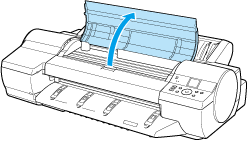
- Remove the Cleaning Brush (a).
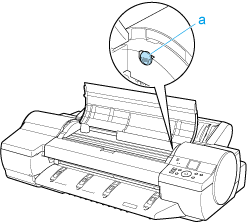
- Using the back of the Cleaning Brush, move the first Switch to the side opposite ●.
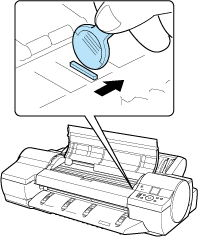
- Refer to the following table to confirm the number on the Platen (a) that corresponds to the size of paper for printing.
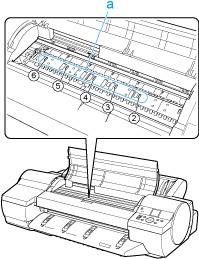
- Using the back of the Cleaning Brush, move the Switch to the side opposite ●, corresponding to the size of the paper for printing.
In this case, note that you will move the switch in the opposite direction from the direction in step 4.
- Close the Top Cover.
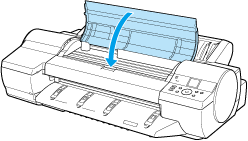
12. 5. 13. Troubleshooting > Problems with the printing quality >
The contrast becomes uneven during printing
The contrast becomes uneven during printing
| Cause | Corrective Action |
| The paper feed amount is out of adjustment. | Adjust the feed amount.
(See "Adjusting the Feed Amount (7.3.1).")
|
| The type of paper specified in the printer driver does not match the type loaded in the printer. | Load paper of the same type as you have specified in the printer driver.
(See "Loading Rolls in the Printer (6.2.2).")
(See "Loading Sheets in the Feed Slot (6.3.1).")
|
| Make sure the same type of paper is specified in the printer driver as you have loaded in the printer.
1. Press the Stop button and stop printing.
2. Change the type of paper in the printer driver and try printing again.
|
12. 5. 14. Troubleshooting > Problems with the printing quality >
The length of printed images is inaccurate in the feeding direction
The length of printed images is inaccurate in the feeding direction
| Cause | Corrective Action |
| In the Control Panel menu, Adj. Priority is set to Print Quality. | Set Adj. Priority to Print Length in the Control Panel menu, and then execute Adjust Length.
(See "Adjusting the Feed Amount (7.3.1).")
|
| The type of paper specified in the printer driver does not match the type loaded in the printer. | Load paper of the same type as you have specified in the printer driver.
(See "Loading Rolls in the Printer (6.2.2).")
(See "Loading Sheets in the Feed Slot (6.3.1).")
|
| Make sure the same type of paper is specified in the printer driver as you have loaded in the printer.
1. Press the Stop button and stop printing.
2. Change the type of paper in the printer driver and try printing again.
|
12. 5. 16. Troubleshooting > Problems with the printing quality >
Documents are printed in monochrome
Documents are printed in monochrome
| Cause | Corrective Action |
| In the Advanced Settings of the printer driver, Monochrome or Monochrome (Photo), is specified in Color Mode. | In the Advanced Settings of the printer driver, specify Color in Color Mode and try printing again. |
| The Printhead nozzles are clogged. | Print a test pattern to check the color ink nozzles and see if they are clogged.
(See "Checking for Nozzle Clogging (11.2.2).")
|
12. 5. 17. Troubleshooting > Problems with the printing quality >
Line thickness is not uniform
Line thickness is not uniform
| Cause | Corrective Action |
| In the Special Settings dialog box of the Windows printer driver, Fast Graphic Process is selected. | Access the printer driver Properties dialog box from Print in the File menu of the source application, and follow these steps to print.
1. Clear the option Open Preview When Print Job Starts on the Main sheet.
2. Clear the option Page Layout on the Layout sheet.
3. Click the Special Settings button on the Layout sheet to display the Special Settings dialog box, and then clear the option Fast Graphic Process.
|
| The blue Switch on the platen is set incorrectly. | Move the Switch numbered corresponding to the size of paper for printing opposite to the ● position.
(See "Setting the Blue Switch on the Platen (12.5.12).")
|
| The type of paper specified in the printer driver does not match the type loaded in the printer. | Load paper of the same type as you have specified in the printer driver.
(See "Loading Rolls in the Printer (6.2.2).")
(See "Loading Sheets in the Feed Slot (6.3.1).")
|
| Make sure the same type of paper is specified in the printer driver as you have loaded in the printer.
1. Press the Stop button and stop printing.
2. Change the type of paper in the printer driver and try printing again.
|
|
| Incorrect Printhead alignment value. | When printing fine lines or text at high precision on glossy or semi-glossy photo or proofing paper, set the optimal Printhead height before aligning the printhead.
(See "Enhancing Printing Quality (7.1.1).")
|
| In the Control Panel menu, use a lower Head Height setting.
(See "Troubleshooting Paper Abrasion and Blurry Images (Head Height) (7.2.4).")
|
|
| Depending on the type of paper, the thickness of printed lines may be noticeably inconsistent. | Select High-Precision Text and Fine Lines in the printer driver.
(See "Giving Priority to Particular Graphic Elements and Colors for Printing (2.3.4).")
|
12. 5. 18. Troubleshooting > Problems with the printing quality >
Lines or colors are misaligned
Lines or colors are misaligned
| Cause | Corrective Action |
| The Printhead is not being aligned correctly. | Adjust the Printhead alignment.
(See "Automatic Adjustment to Straighten Lines and Colors (Head Posi. Adj.) (7.2.2).")
(See "Manual Adjustment to Straighten Lines and Colors (Head Posi. Adj.) (7.2.3).")
|
| When printing fine lines or text at high precision on glossy or semi-glossy photo or proofing paper, set the optimal Printhead height before aligning the printhead.
(See "Enhancing Printing Quality (7.1.1).")
|
|
| In the Control Panel menu, use a lower Head Height setting.
(See "Troubleshooting Paper Abrasion and Blurry Images (Head Height) (7.2.4).")
|
|
| The type of paper specified in the printer driver does not match the type loaded in the printer. | Load paper of the same type as you have specified in the printer driver.
(See "Loading Rolls in the Printer (6.2.2).")
(See "Loading Sheets in the Feed Slot (6.3.1).")
|
| Make sure the same type of paper is specified in the printer driver as you have loaded in the printer.
1. Press the Stop button and stop printing.
2. Change the type of paper in the printer driver and try printing again.
|
|
| Depending on the type of paper, printed lines may be noticeably misaligned. | Select High-Precision Text and Fine Lines in the printer driver.
(See "Giving Priority to Particular Graphic Elements and Colors for Printing (2.3.4).")
|
12. 5. 19. Troubleshooting > Problems with the printing quality >
Borderless printing is not possible
Borderless printing is not possible
| Cause | Corrective Action |
| When executing borderless printing on A1 (594 mm) or A2 (420 mm) rolls, the Spacer for Borderless Printing was not attached to the Roll Holder. | For borderless printing on A1 (594 mm) or A2 (420 mm) rolls, attach the included Spacer for Borderless Printing to the Roll Holder.
(See "Loading Rolls on the Roll Holder (6.2.1).")
|
12. 5. 20. Troubleshooting > Problems with the printing quality >
Problems with the printing quality caused by the type of paper
Problems with the printing quality caused by the type of paper
For paper-specific troubleshooting tips to improve the printing quality, refer to the Paper Reference Guide. (See "Types of Paper (6.1.1).")